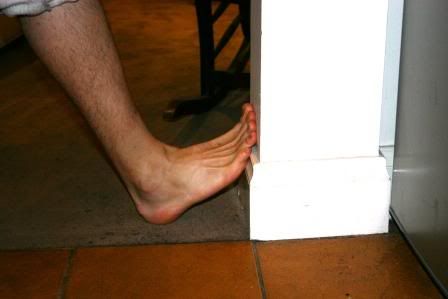In my last post, I wrote about how a persistent ankle problem is preventing me from making better gains with the VJB by limiting the amount of squat and deadlift work I can do. Long story short, poor ankle mobility has ALSO meant my leg compensates in weird ways when I play ball, and I have a noticably shorter Achilles tendon on the right leg than on the left. According to the VJB, this is going to be a problem for my vertical leap.
WHY IS THE ACHILLES IMPORTANT IN JUMPING: Kelly writes in the Vertical Jump Bible "Many athletes who can jump high and/or run fast have physical characteristics such as long lower legs, high calves and long Achilles tendons. The length of the Achilles tendon gives them a leverage advantage and enhances plyometric ability because it acts like a long rubber band. If you take 2 rubber bands of equal strength, the longer one will fly further".
Now, I don't pretend to be a sports physiology expert, but the point of stretching muscles is to make them longer and more flexible, so stretching the Achilles must be a good thing for jumping, right? I did some research online and found this to be the deepest, most effective Achilles stretch.
THE STRETCH:
1 - Stand facing a wall. Dig your heel into the floor right near the wall, with the ball of your foot resting on the wall itself so that your foot forming a 30-45 degree angle with the wall (see picture).
2 - Slowly, keeping your leg slightly bent, push your knee toward the wall without moving your heel or the ball of your foot at all. Your shin should get closer to becoming paralell to the wall. You'll feel the pull down the back of your lower leg - resist the urge to push hard. This should be a gentle stretch.
This is the best Achille stretch I've found - most of the other stretches I've been shown don't go deep enough or tend to work the calf more than the achilles. In alot of ways, it's very similar to the traditional calf stretch where you push against the wall, but I wouldn't recommend this stretch for beginners - the Achilles is a very painful tendon to damage and it is extremely tough to come back from an Achille injury, so make sure you know your stretching limits before doing this.
Sunday, August 16, 2009
Good Achilles tendon stretch: why is the Achilles important for jumping
Posted by Just another dude in the playground at 7:14 AM 0 comments
Wednesday, August 5, 2009
More progress: August 6th 2009
It's been a while since I posted here, since I've been travelling a little for work and also went on holidays for a week. I haven't had a chance to measure my exact vertical leap for a while, but some interesting things happened today and last night - firstly, I blocked 2 shots last night. In itself, thats not all that amazing - I block shots all the time - but these blocks were huge! I blocked one guy with my elbow (!), the other I blocked with 2 hands. My hops are really starting to help me shine on the court. I can also see a marked difference in my on-court speed. On the fast break, I'm getting down the court as fast as anyone else on the court - I'm now going for heaps more LeBron-style chase downs and blocking shots from behind on fastbreak defense.
The second interesting thing that happened is that I've noticed I nearly hit my head on the roof of the group-exercise-room I do my plyo's in. The roof is probably standard height (I guess it'd be around 9-10 feet high), but I can see a marked difference in how close I'm getting to hitting my head from when I first started, which is really motivating. In doing the Rim jump exercise, I'm now aiming to hit my head on the roof within the next few weeks. Just gotta get down to the courts this weekend (god willing) and measure that vert again to see what gains I've made.
In other news, I'm feeling a recurrence of an old ankle injury is holding me back from progressing faster - I have poor mobility in the joint after a number of prior accidents, and so squats and deadlifts are difficult since my ankle won't dorsiflex at all past 90 degrees. This also means that the elastic reaction that comes from my foot dorsiflexing and then plantarflexing when I jump is decreased, which effects my jump. Think of it like this - if you are throwing a punch and are able to cock your arm right back, you will hit alot harder than if you are able to cock your arm back 1 inch to throw the punch... I'm effectively doing the equivalent of throwing 1-inch punches when I jump (the problem is, I'm not Bruce Lee, so 1 inch punches don't really work for me) due to my ankle problems. As such, I've only been doing shallow squats to work the lower back and bum, and single-foot leg presses to work the quads and hammies - I cannot manage much more than this due to the injury. This seems to be working OK so far, but I still feel that this ankle problem could be a considerable barrier to further progress with VJB, since it will effectively limit how effectve my strength training will be.
Labels: athletics, basketball, fitness, gym, strength, training, vertical leap, vjb
Posted by Just another dude in the playground at 8:55 PM 0 comments